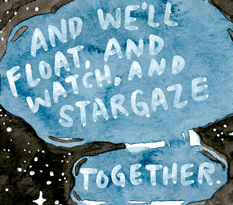I like hand lettering a lot. There’s a certain character that linear insufficiency, messiness, brings to a work.
In mass produced superhero comics, where each part of the production process is assigned to a specialist–script writer, penciller, inker, flatter, colourist, letterer, designer, junior editor, senior editor, marketing specialist, assistant to someone somewhere–the final product must fit a certain mould. These comics aren’t without imperfections, charm, or artistic ambition, but they are in many respects far more precise than comics made by one person, by hand on paper (or hand on tablet). Colourists work with the production process, the specific character of the book, and the brand identity of the publisher in mind. Letterers try to add a special charm while also maximizing readability and regularity. You don’t want to risk printing errors for the sake of a sweet typeface.
Here are the first two pages of Ashley Franklin’s The Ghost Dream, a comic I found through Twitter:
Isn’t that nice? The Ghost Dream is part of a series of essays and comics that POME Mag ran on seances, ghosts, and related supernatural topics. This was in response to the hellacious year that 2016 has been and our need to consider another world that might exist in concert with/on top of our own. (I’m a strict unbeliever myself, but I’m always here for a witchy, ghostly comic.)
The comic itself is about one of those common anxiety dreams that plague most of us from time to time, where we discover that our life means nothing and everyone we love would be fine, if not better off, without us around to drag them down. Oh, so fun! I’m more prone the creeping dread of dreaming myself into a classroom led by an aggressive teacher who will make me give a speech or answer questions to which I don’t have the answers, but this too is grade A anxiety for sure.
But for Franklin, it’s not a simple case of loneliness and social anxiety being processed by our unconscious brain; The Ghost Dream represents a possible end of life scenario that, for her, isn’t so bad. Instead of complete annihilation, a perpetual state of liminality and voyeurism; a vagueness on the edge of others lives. That’s okay, I guess. Though not an afterlife I’d personally be down for. That ambivalence, the presence of anxiety and reassure is made present in The Ghost Dream through multiple vectors: her words and the shape of them, her use of light and colour, and her figures.
The expression and body language of her dream people and ghost body changes as she contemplates first the anxiety of the death dream, and second the reassurance of a ghostly afterlife. So too does the depth of colour in her speech bubbles, from inky to royal to slate blue, and the heaviness of her letters. It’s not an obvious light-to-dark effect, where the words get lighter along with her heart. They don’t, for example, fade away into a wispy white in the last panel. But colour does deepen in panels with more emotional weight, as though her hand rested there, heavy with ink. Likewise her lettering doesn’t GET EMPHATIC with changes in size, colour or typeface. Its character is more determined by her panel layouts, the amount of space to which she gives each thought. It curls around the shape of those speech bubbles, cramped in the case of descriptive asides, spacious in the case of points she wants to linger.
Her lettering is imperfect. Sometimes the arm of a G goes a bit long. Sometimes it gets squished into the round body of the letter. There are white points where the tip of her marker paused as she carefully wrote out “night air.” It’s imprecise but also deliberate. It lends to the confessional, bedtime tone of the comic. It feels far more personal than anything from Adobe, more than even a custom font. It, along with every other imperfection in the comic contributes to the sense that this is a note passed to you by your new internet acquaintance, Ashley Franklin, who has some interesting thoughts to share about anxieties, social and otherwise, and the possibility of a ghostly afterlife. It’s a personal comic, and every aspect of its visual design and execution emphasizes that. This is why I like hand-lettering–it adds so much character to a comic.







